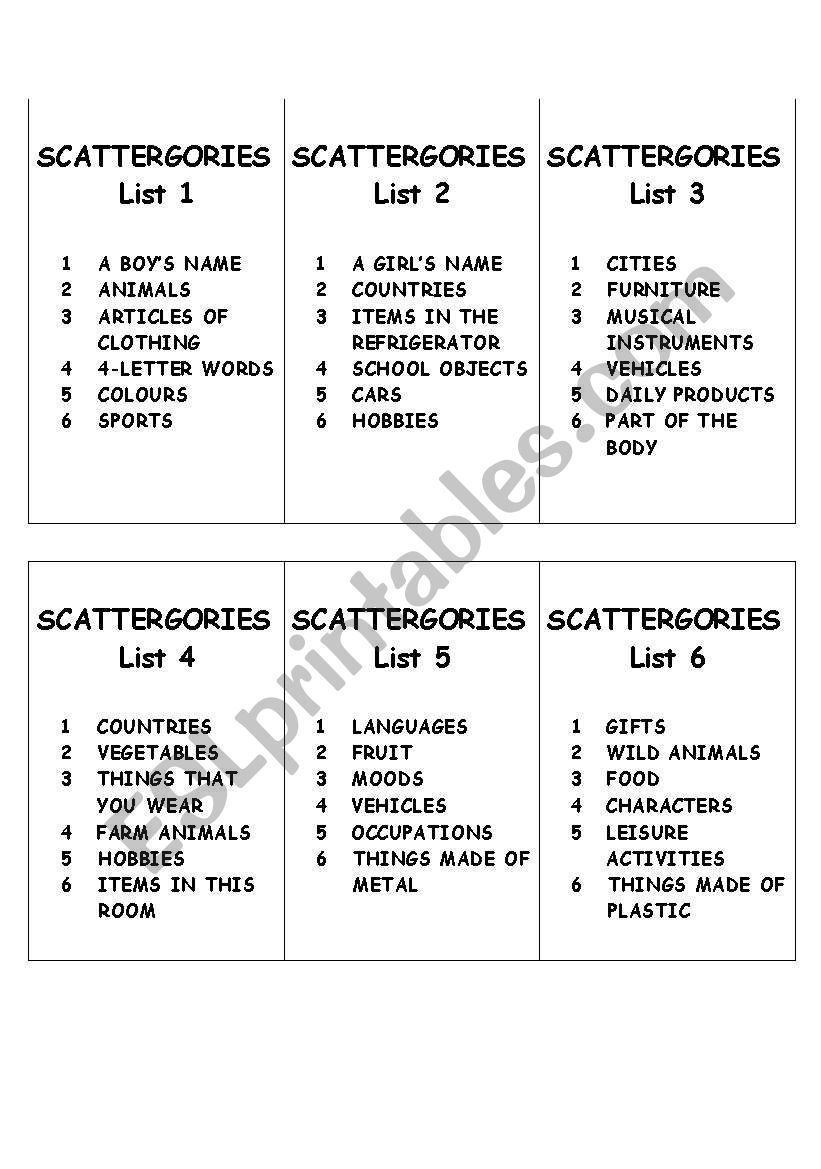

For no answer or an answer that other players do not accept, a player gets 0 points. So, you would have to come up with say, a college major, a boys name, or. For an answer that someone else also has, a player gets 5 points. Scattergories offers players twelve of 144 categories and one of twenty letters each turn, which they have to pair. For an answer that no one else has, a player gets 10 points. Just use one of our examples Scattergories lists below Example Scattergories Lists List 1 1. To score the round, players read their answers aloud. You can also use a timer, but that eliminates part of the strategy. Any player can stop the round this way whenever she likes. Play stops when one of the players says basta para mí, basta para todos (or tutti frutti, alto el fuego, stop, etc.). Of course, you can also make a set of letters and draw one or choose a letter using any random method.Įveryone writes the letter in the space on the left, and then tries to think of a word for each category that begins with that letter. Whatever letter the person is saying when she hears basta is the letter for that round. To play, players select a letter this way: one person says the alphabet very quickly and someone else stops her by saying basta. Pick one of the 5 lists: Romance, February, Flowers, Candy, or Love.
#Kid scattergories lists how to#
Your friends and family How to Play Valentine’s Day Scattergories.

An alphabet die or our printed letter squares. How to play the Spanish language game Basta Printed Valentine’s Day Scattergories lists. If you dont know the game - you pick a list, pick a letter (I use random name generators online to pick one at random) & give the kids a time limit to think of words to fit the categories beginning with that letter. This is how we play, but you can adapt it for different ages and language levels. Description 12 Scattegories lists to print, ready to use. Scattergories Categories Lists Foods you eat for breakfast Deserts Something you buy for valentines day Colours Ice cream flavours Parts of the body. Repeated answers are worth fewer points, so kids who play a lot memorize unusual fruits like rambután. This Spanish language game is so common and popular, that online you can find lists of colors for every letter of the alphabet, and of fruits and vegetables that start with i, q, o, r, k, t, ñ, x, y, z, w. Of course, kids can easily make their own, too.
#Kid scattergories lists download#
You can download the printable version below and another that is more specific. This is what my simple game board looks like. When I play with children learning Spanish, I usually include verbo or acción as a category. Categories can be anything though, including pop culture references like marca, música, famosos/as. Common categories include nombre, cosa, animal, fruta o verdura, color, país o ciudad and apellido. To play this traditional children’s game in Spanish, everyone makes a game board with categories. It is a category game in Spanish – the original, non-commercial version of Scattergories. They call it Basta, but it has lots of names: Tutti frutti, ¡Mercadito!, Stop, Lápiz quieto, Animales con E, Alto el fuego, Ensalada rusa. My children played this game in Spanish all the time with their friends in Mexico.


 0 kommentar(er)
0 kommentar(er)
